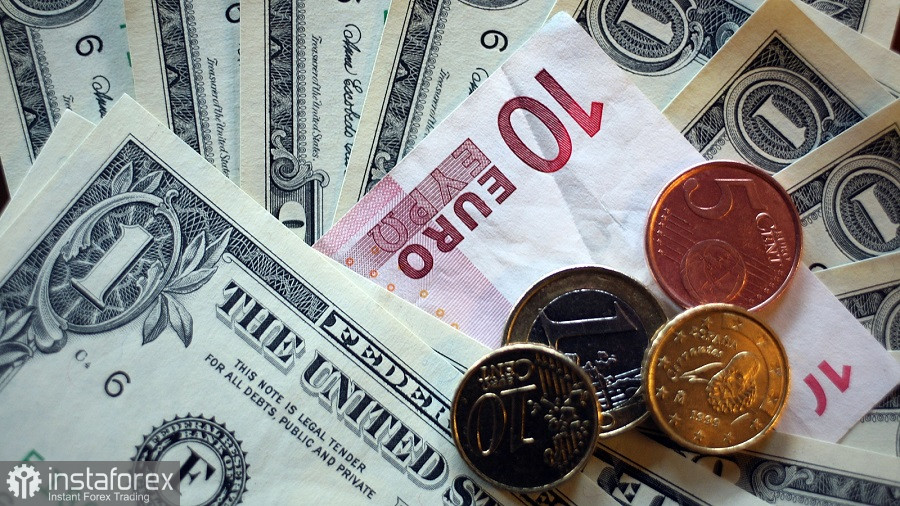Upward correction or trend reversal? I think many traders of the EUR/USD pair are asking this question. The rapid rise in the price is primarily due to the weakening of the greenback, although the external fundamental background also contributed to strengthening the bullish momentum. In just 10 days, the pair has grown by more than 300 points, easily overcoming key resistance levels – 1.0000, 1.0050, 1.0200 and even 1.0300.
However, despite such a confident blitzkrieg, it is still too early to talk about a trend reversal. Not so long ago – in August of this year – EUR/USD bulls were already trying to gain a foothold within the 3rd figure after a decline to the 0.9950 mark. Amid a slowdown in US inflation indicators, bulls then reached 1.0370. They stayed in this price area for only two days, after which the pair began to slide down again. Let me remind you that at the beginning of August, many inflation indicators came out in the red zone: the consumer price index in the United States, the producer price index and the import price index. The market began to speculate about how the Federal Reserve will react to the slowdown in the growth of these indicators. These "dovish-like" arguments, in fact, provoked the summer price rise to the area of the third figure. Why were bulls unable to settle in this price area? And why couldn't you develop your success?

The fact is that most traders have come to the obvious conclusion: despite the slowdown in growth, inflation in the United States is still at too high a level, allowing the Fed to tighten monetary policy – albeit not at an aggressive, but at a moderate pace.
Remembering these events three months ago, we can talk about deja vu: after all, US inflation has slowed down again, and the market is talking about the Fed's possible reaction. And amid this news flow, the EUR/USD pair again climbed into the area of the 3rd figure. Everything is like a carbon copy!
Indeed, the events are of a similar nature, but there are some rather important differences. To date, representatives of the Fed, as they say, "out loud" recognize the expediency of slowing down the pace of tightening monetary policy. Several Fed members made similar statements at once, in particular, Patrick Harker, Esther George, Mary Daly. Fed Chairman Jerome Powell did not rule out such a scenario. Therefore, now we can say with some confidence that the Fed will make the appropriate decision in December, raising the rate not by 75, but by 50 points. According to the CME FedWatch Tool, the probability of this scenario is estimated at 80.6%.
What does this mean? First of all, the fact that in the summer the issue of slowing down the rate increase was debatable, whereas today it is practically a fact. A fact that has been actively played out by the market since last week, when an inflation report was published in the United States. Judging by the current dynamics of EUR/USD, the active phase of this process has ended – the upward momentum is fading. And after it finally fades away, a natural question will arise: what to do next? In order to develop a further bullish attack, appropriate fundamental factors are needed. But the fact is that the Fed is not going to change the hawkish course, pause or underestimate the ultimate goal of the current tightening cycle of the monetary policy. Moreover, Powell has repeatedly said that the central bank will keep the rate at a high level even when the growth of inflation will steadily slow down. None of the Fed members has yet stated the opposite. At the same time, Powell said at the November meeting that "the speed (of the rate hike) is not so important to achieve the goal."
Thus, the very fact of slowing down the pace of monetary policy tightening will not be able to "pull" the upward trend. This information guide allowed EUR/USD bulls to organize a large-scale correction, but in my opinion, it is still impossible to talk about a trend reversal. If the representatives of the Fed in the near future will focus their attention on the fact that inflation in the United States is still at too high a level, the dollar will quickly regain its position.
As for the euro, it is necessary to recall the economic forecast of the European Commission, which was published last Friday. According to the economists of the department, the economy of the EU and the euro area will shrink in the fourth quarter of 2022 and the first quarter of 2023, that is, Europe is already entering a state of technical recession. It is obvious that in such conditions it will be difficult (if at all possible) for the European Central Bank to tighten monetary policy at an aggressive pace next year. The Fed will be one step ahead of the ECB in this regard, and over time this gap will only increase. Therefore, even steady signs of a slowdown in the growth of US inflation are unlikely to break the dollar: I believe that after a corrective surge, EUR/USD bears will seize the initiative for the pair.
The nearest downward target is 1.0280 (the Tenkan-sen line on the four-hour chart). The main target in the medium term is the 1.0150 mark – the average line of the Bollinger Bands, coinciding with Kijun-sen on the same timeframe.
 English
English 
 Русский
Русский Bahasa Indonesia
Bahasa Indonesia Bahasa Malay
Bahasa Malay ไทย
ไทย Español
Español Deutsch
Deutsch Български
Български Français
Français Tiếng Việt
Tiếng Việt 中文
中文 বাংলা
বাংলা हिन्दी
हिन्दी Čeština
Čeština Українська
Українська Română
Română

